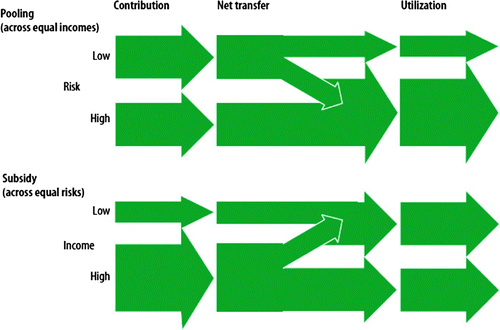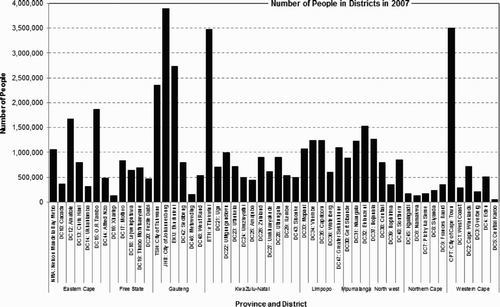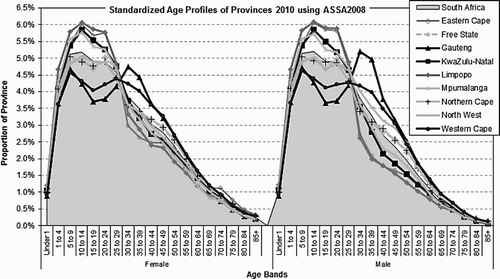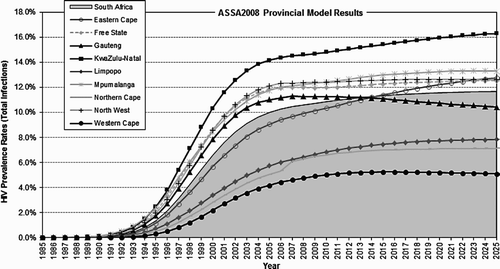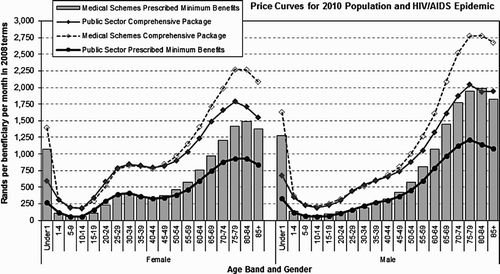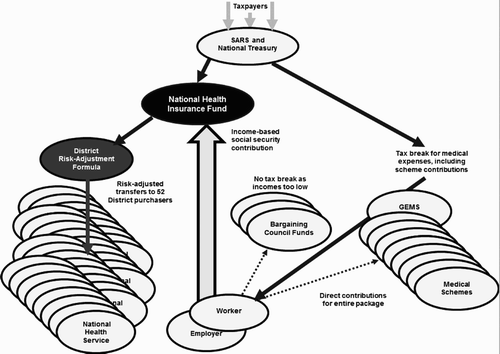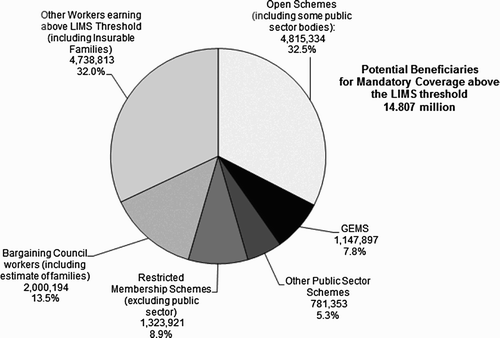Abstract
A National Health Insurance system has been proposed for South Africa and two of the seven guiding principles are that there be social solidarity and equity. These will require both risk cross-subsidies and income cross-subsidies to be engineered into the health care financing system. This paper considers the need for risk adjustment at a provincial level using at least age, gender and HIV prevalence. The proposed single purchaser model with 52 purchasing districts is shown to be problematic. An alternative multiple purchaser model is proposed which includes existing health funds and employer-based health care arrangements. The role of risk adjustment is described at various levels of the system and it is demonstrated that equity and social solidarity can be achieved in a multiple purchaser system.
1. Introduction and context
The Green Paper on National Health Insurance (NHI) for South Africa was released for comment in August 2011 (DoH, 2011). The Paper states that NHI ‘is intended to ensure that all South African citizens and legal residents will benefit from health care financing on an equitable and sustainable basis’. Seven guiding principles for NHI are listed: the right to access, social solidarity, effectiveness, appropriateness, equity, affordability and efficiency. Of these, two are important for the design of the financing system:
| • | Social solidarity is said to mean the ‘creation of financial risk protection for the entire population that ensures sufficient cross-subsidisation between the rich and the poor, and the healthy and sick’. | ||||
| • | Equity is described as ensuring ‘that those with the greatest health need are provided with timely access to health services. … Equity in the health system should lead to expansion of access to quality health services by vulnerable groups and in underserved areas’. Equity is also linked to the concept of fairness. | ||||
Both risk and income-related cross-subsidies could occur among the members of the same pool [as in Costa Rica and UK National Health Service]… or via government subsidies to a single or multiple pool arrangement. … Cross-subsidization can also occur among members of different pools (in a multiple pool system) via explicit risk and income equalization mechanisms [as in Argentina, Colombia and The Netherlands]. Even under single pool organizations, decentralization, unless accompanied by equalization mechanisms for resource allocation, may result in significant risk and income differences among decentralized regions [as in Brazil]. (WHO, 2000)
2. The proposed ‘single purchaser’ model
The NHI Green Paper (DoH, 2011) envisages a single risk pool with 52 district purchasers of health care. While in various parts of the document the NHI is described as a ‘single payer’, a ‘single funder’ and a ‘single purchaser’, the section on ‘Unit of Contracting’ describes multiple district purchasers: ‘It is envisaged that the District Health Authority, as part of the health service provision system, will be established and given the responsibility of contracting with the National Health Insurance in the purchasing decisions for health services.’
It would seem that each district will be required to plan for services for the local population, negotiate with accredited public and private providers to deliver health care, and monitor the performance of the contracted providers. Issues related to capacity constraints and the need for initial support of some districts are acknowledged. The Department of Health announcedFootnote2 that NHI would be piloted in 11 districts from April 2012 but the pilot projects deal more with primary health care delivery, the envisaged community-based teams and school health issues. The decentralisation of purchasing to district authorities does not seem to be part of the pilot projects as yet but could emerge later in the envisaged five years of testing.
The NHI Green Paper envisages a risk-adjusted payment at primary care level: ‘accredited providers will be reimbursed using a risk-adjusted capitation system linked to a performance-based mechanism.’Footnote3 The payment ‘will be calculated on the basis of a risk-adjusted capitation formula taking into account key factors such as population size, age and gender and disease/epidemiological profile’ (DoH, 2011).
While this is sound in theory, the notion of 52 district-based purchasers involves a number of practical difficulties. At provincial level there is a clear understanding of the differences in age and gender profile, as well as levels of the HIV/AIDS epidemic, as discussed in Section 3 below. However data at district level are not modelled in the same way and information on age and gender by district is collected only at long intervals.
Census 2001 and the Community Survey 2007 (a survey by Stats SA of 2.5% of all households) collected data at district and sub-district level outside metropolitan areas but all metropolitan areas are treated as single districts. shows the size of each of the 52 districts in 2007 and illustrates the major concern with using districts as units for health care planning, purchasing and delivery. Gauteng has three very large districts, of which City of Johannesburg is the largest with 3.9 million people. Another Gauteng district, Metsweding, has only 154 000 people. In KwaZulu-Natal, eThekwini has 3.5 million people, while Amajuba, the smallest district in this province, has only 442 000. The Western Cape is even more extreme, with the City of Cape Town having 3.5 million people and Central Karoo only 56 000. These very large differences in the size of district mean that the plan in the NHI Green Paper to have one team of (expensive and scarce) specialists per district makes little sense.
The Western Cape Department of Health deals with this issue by demarcating additional sub-districts in the metropolitan area for planning and health care delivery purposes. Rather than one team per district, each province should have a designated number of specialists based on the demographic profile and the province should be able to allocate these as it sees fit. Such a strategy would not require any more specialists than the current plan but would distribute these resources more equitably.
In any event, obtaining any data on the number of people in the districts currently happens only at Census time, which is once every 10 years. Registration of the population in each district would overlap efforts of the Department of Home Affairs and the Independent Electoral Commission. Having real-time information on where people live and being able to pay for every health visit to another district would require a complex and prohibitively expensive administrative system. As Dorrington (2005) points out, ‘It is quite possible that clinics near the borders of the health districts also service people from neighbouring health districts’.
A capitated payment to providers on the basis of people registered is an incentive to inflate registered numbers. The registration of the population with primary care providers would require a massive administration system to ensure that people are not registered twice or that fraudulent or ‘ghost’ patients are not registered. This would place an unnecessary additional cost on the public sector delivery system.
The NHI Green Paper also proposes organising primary care teams at ward level within districts. Wards are voting districts as used by the Independent Electoral Commission. The boundaries of wards and districts are determined by the Municipal Demarcation Board. As at September 2010 there were 4277 wards in eight metropolitan councils, 45 districts and 231 local municipalities (Gabara, 2010). The envisaged 52 districts in the Green Paper should be these 45 districts plus the eight metropolitan councils (the discrepancy between 52 and 53 districts is not reconciled in the Green Paper).
A problem with using these voting districts for organising health care delivery is that the boundaries are adjusted regularly. The Municipal Demarcation Board (2011) has announced more than 500 possible boundary changes to be implemented before the national and provincial elections in 2014.
While NHI is described as a ‘single purchaser’ model, it is in reality a model with multiple regionally based purchasers. There are serious logistical concerns with organising health care planning and contracting at district level and there is no compelling argument to replace the nine provinces as the units of health care planning and delivery.
3. A formula for risk adjustment at provincial level
If NHI were to be implemented with nine provincial purchasers, risk adjustment would need to be applied to the amounts allocated to each of the provinces.
At provincial level there is a clear understanding of the differences in age and gender profile, as well as projected levels of the HIV/AIDS epidemic, as shown in and . There are substantial differences in the age and gender profile between provinces, which affects the price or the capitated amount needed for health care. shows that the Western Cape and Gauteng have more working-age adults than the other provinces. The provinces with fewer economic opportunities tend to have fewer working-age males and proportionally many more children. This is a reflection of economic migration to other provinces in search of work opportunities, with the family remaining in the original province.
A significant feature of the HIV/AIDS epidemic in South Africa has been the very different levels of infection by province. KwaZulu-Natal continues to have the highest HIV prevalence and the Western Cape the lowest. Abrupt changes in prevalence are due to boundary shifts in some provinces (McLeod, 2011b). These differences in the HIV epidemic by province mean that there is a wide disparity in the need for treatment by province and indicate the need for a risk-adjusted payment to the provinces which include HIV/AIDS as a risk factor.
The cost of delivering health care to a population is largely determined by the package of health care, age and gender, as shown in . This figure shows the very strong pattern by age and gender in the cost of health care. Children under the age of one year are much more expensive than slightly older children. Not all under-one-year-olds are expensive but there are a few very high cost babies, usually those born prematurely. Male babies are more expensive than female babies as they tend to be less healthy and there may be costs of circumcision soon after birth. Children of school-going age have the lowest costs but as they leave school costs escalate rapidly. Costs in the early adult years are influenced by maternity costs, vehicle accidents, substance abuse and the consequences of violence. Female costs are much higher than male because of the ‘maternity bump’ in the child-bearing years. At age 40, male and female costs are about equal and after age 40 the impact of lifestyle choices in early adulthood begins to show in the high costs for chronic disease. Male costs are higher than female from about age 40 onwards for the rest of life. Both male and female costs decline from age 80 onwards.
Figure 5: The impact of benefit package, age and gender on the cost of health care in the private sector
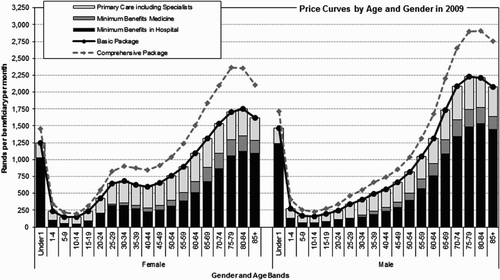
also shows the impact of different benefit packages on the cost of health by age and gender. The Basic Package is equivalent to the Prescribed Minimum Benefits that all medical schemes must provide, together with comprehensive primary care. The Comprehensive Package is equivalent to the medical scheme packages with the highest levels of cover.
The patterns in are taken from data from the private sector (McLeod et al., 2010). The data underlying the patterns covered some 1.7 million lives and were extracted from a very large administrator in 2008. They were adjusted to 2009 with medical scheme component inflation as used for the risk equalisation calculations and published by the Council for Medical Schemes.
It has not yet been possible to study the same curves in the public National Health System (NHS)Footnote4 in South Africa, but the general shapes are expected to be similar, even if the level of the price curves will be different. Cost curves by age and gender are applied to the different age-gender profiles of groups to determine the relative cost of a particular group.
Areas where the public NHS cost curves would be expected to be different from the medical scheme cost curves are the following:
| • | The HIV prevalence in the NHS is higher than used for medical schemes and hence the cost of treating HIV/AIDS is higher. | ||||
| • | The cost of under-one-year-olds should be lower as there is greater rationing of care for premature babies in the public sector. | ||||
| • | The fertility rates in the NHS are expected to be higher than in the medical scheme population. However, in recent years there has been a large amount of anti-selectionFootnote5 against medical schemes for maternity care. Pregnant women and women in their child-bearing years have joined medical schemes in greater than expected numbers in order to have deliveries in private hospitals. | ||||
| • | There are far fewer Caesarean sections in the public sector, with rates of 160 per 1000 live births across all public sector hospitals in 2003 (Day & Gray, Citation2008). The rate in medical schemes was 619 per 1000 live births in a study in 2005 (Risk Equalisation Technical Advisory Panel, 2007). | ||||
| • | There is expected to be a different mix of chronic diseases (more respiratory and less cardiac than in medical schemes). However, there is no empirical evidence that the overall burden and cost of disease (excluding HIV/AIDS) is different. It is expected that there are higher rates of tuberculosis and infectious diseases, and higher rates of violence, in the public sector. | ||||
| • | On the other hand, there is significant anti-selection against medical schemes, with those with serious chronic disease (such as renal failure) joining schemes to avoid the rationing in the public sector. This means that the curves may be higher in the chronic disease years than might be experienced in a public system. | ||||
The differences in the age and gender profile of provinces, together with the relationship between age, gender and the price of health care, translate into substantial differences in the rand value that should be allocated to each province. Using the public sector price curves for 2010 with the age and gender profiles for 2010 from ASSA2008 gives results as shown in . The results are indexed so that South Africa = 100. The table shows that if only age and gender are used for the provincial allocation formula, then the Western Cape needs to be allocated 107.7 per person, relative to 100.0 per person for South Africa as a whole. However, once HIV is taken into account, the amount for the Western Cape falls to 104.3 in 2010. KwaZulu-Natal is the greatest beneficiary of a formula that uses HIV as well as other risk factors.
Table 1: Impact of age, gender and HIV profiles on provincial formula
Note that the amounts to be transferred to each province change over time. The provinces are predicted to have different rates of aging and the HIV epidemic progresses differently across the provinces. The table shows the importance of allocating funds on the basis of expected risk and not simply equally per person. A risk-adjusted formula for calculating the health budget for the nine provinces has been discussed by the Department of Health and the National Treasury and a formula with demographic and socioeconomic risk factors has been implemented.
4. Equitable subsidies in a multiple purchaser model
As I explained in the introduction to this paper, the proposed ‘single-payer’ NHI model is in fact a multi-payer model. I argued that nine provincial purchasers would be a better solution than 52 district purchasers. However, the NHI model as envisaged in the NHI Green Paper (DoH, 2011) fails to deal with the extensive employer-related health arrangements in South Africa, including the benefit schemes for bargaining council members and the medical schemes for public sector workers, parliament and traditional leaders (McLeod, 2010c).
The NHI Green Paper says that the transitional process from the current to the proposed NHI environment will occur in three phases over 14 years of implementation. While the legislative process for NHI was planned to begin in January 2012 and the NHI Fund staff be appointed by 2014, no dates are given for changes to the medical schemes environment.
I believe the possibility exists that medical schemes and bargaining council schemes will co-exist for some considerable time with the NHI Fund. It is thus necessary to address the equity and social solidarity implications of having these arrangements alongside the public NHS. The possible flow of funds is illustrated in .
At present, medical scheme members pay twice for health care: their medical scheme contributions and their taxes which fund the public sector. The NHI Green Paper (DoH, 2011) accepts that voluntary medical schemes might continue but expects to have members pay three times: through taxes that fund the public NHS, through a new social security contribution for health care (as yet to be determined), and contributions to their medical scheme.
It would increase the acceptability of NHI as an alternative to medical schemes if any social security contribution is introduced only once public sector health services are of a much better quality and when they have become a credible alternative to the private sector. There is a timing difficulty in that revenue collected from social security contributions is needed in order to improve the quality of the public sector services and will in all likelihood need to be introduced before the quality has been improved. The issue is that the extra funds are needed to improve health quality but it is difficult to implement a payment system until the quality is improved. As a result, medical schemes would not be affordable for most members and this could force members to leave schemes and use only the NHI.
The NHI Green Paper says that the tax break in respect of medical scheme membership will also be removed. However, there is no unanimity in government on this issue and the National Treasury has published a discussion document (2011) on converting the tax break to a tax credit with effect from 2012, saying this will facilitate the introduction of NHI. The tax credits have been introduced by the South African Revenue Service (SARS) with effect from 1 March 2012, with a phasing-in period for those over age 65 until March 2014.
Some form of payment from tax collections to those using other forms of health insurance is essential in the interests of treating people fairly. It is not widely appreciated that many income earners would face catastrophic expenses if they did not have a medical scheme and attempted to use public health care. Currently, Department of Health policy (DoH, 2009) is that anyone earning over R6000 per month, or R8333 per month for a household, must pay in full when using public hospitals. People who have medical schemes also pay in full for use of public hospitals.
The Department of Health gives the reason for the lack of affordable access to public facilities at these income levels as follows: ‘This is to encourage those individuals to take out medical aid’ (DoH, 2009). In the development of the NHI Green Paper there has been no acknowledgement of this Department of Health policy to encourage medical scheme membership and there appears to be no plan to repeal the subsidy policy.
Anyone who earns over R6000 per month and does not have a medical scheme is thus exposed to personal catastrophic expenditure. It would therefore be fair that this group which is effectively excluded from the public NHS should continue to receive some form of subsidy for health care. It is important from an equity perspective that any subsidy be fair across the public system and private funding arrangements.
The report on converting the tax deduction for medical expenses to a tax credit says:
It is therefore pertinent to take public expenditure on health services, of about R78 billion in 2008/09, as a relevant benchmark. This amounts to about R1600 a year per person, or R1950 a year for South Africans who are not covered by medical scheme membership. The present tax relief deductions, expressed as tax foregone per medical scheme beneficiary, amounted to an estimated R1600 per person in 2008/09.The overall tax relief on medical expenses is therefore broadly proportional on a per capita basis, by comparison with public expenditure on health services targeted at those without medical scheme coverage. (National Treasury, 2011)
Table 2: Government and personal expenditure on healthcare per beneficiary per annum in 2008
The critical comparison is between what government spends on someone using public sector care (R1950 per beneficiary per annum) and what government spends on someone who uses medical schemes (R1600 per beneficiary per annum). An analysis in 2005 showed that the average amount spent on subsidies to medical scheme members was R1441 per annum, compared to the average R1154 spent on NHS users (Ministerial Task Team on Social Health Insurance, 2005). The Taylor Committee report (DSD, 2002) advocated equal amounts being spent on those in the public sector and those in mandatory health insurance.
5. A multiple purchaser model to achieve universal coverage
The NHI Green Paper envisages medical schemes as being a declining group of funders in favour of a single NHI Fund. But this model for achieving universal coverage is by no means the only feasible route and developing countries are encouraged to consider multiple-purchaser models as a long-term feature of their health systems.
The International Labour Organization (ILO) advocates using multiple funders of health care to achieve universal coverage:
In view of the alarming deficit in social health protection coverage in many countries and the ILO's long experience in this field, a new strategy has been developed with the aim of contributing to achieve universal coverage at a global level. … The new strategy responds to the needs of uncovered population groups in many developing countries, the informalization of economies and persisting high rates of unemployment. The approach explicitly recognizes the contribution of all existing forms of social health protection and optimizes their outcomes with a view to achieving universal coverage.Financing mechanisms of social health protection range from tax-funded National Health Service delivery systems to contributions-financed mandatory social health insurance financed by employers and workers (involving tripartite governance structure) and mandated or regulated private non-profit health insurance schemes (with a clearly defined role in a pluralistic national health financing system comprising a number of different subsystems), as well as mutual and community-based non-profit health insurance schemes.Virtually all countries have built systems based on various financing mechanisms that combine two or more of these financing options. The ILO's social health protection policies explicitly and pragmatically recognize the pluralistic nature of national health protection systems and advise governments and other key players in social health protection to pursue strategic systemic combinations of national financing systems … (ILO, 2007)
Relatively little has been written about workplace provision of health care in South Africa, other than through medical schemes. One of the few sources of information is a chapter in the 2007 South African Health Review (Adams et al., Citation2007). Employers in the mining sector have played a substantial role in health care provision since the first fund was set up by De Beers in 1889 (DoH, Citation2002). In recent years the introduction of HIV treatment programmes for workers has been pioneered by the mining sector.
Bargaining Council schemes are a particularly interesting form of workplace health care. They are established under the Labour Relations Act (Act 66 of 1995), which gives bargaining councils the right to establish and administer pension, provident funds, sick pay and medical aids for the benefit of the members. Budlender & Sadeck (Citation2007) found there were 27 Bargaining Councils with funds and that these represented ‘a total of over 800 000 employees and close on 50 000 employers’.
An attempt was made in the middle of the last decade to create an affordable alternative health care funding arrangement for lower income workers that protected core medical scheme principles such as open enrolment, community-rating and minimum benefits. The Low Income Medical Scheme (LIMS) process, led by Broomberg, who reported on it in 2006, investigated the possible ‘establishment of separate medical schemes, or separate options within medical schemes, open only to low income households, which could be subject to a different regulatory environment, including a lower cost prescribed minimum package’ (Broomberg, Citation2006). Legislation to allow for LIMS to be established was sent to parliament in 2008 (RSA, 2008) but was allowed to lapse and has not been resubmitted.
shows the employer-based arrangements for health care in South Africa, combined with the potential coverage if a LIMS environment were introduced. Using data from 2009 (McLeod, 2010c), it was found that some 14.8 million people could be covered under workplace-based health arrangements.
Workplace health arrangements fulfil an important role in health care provision in South Africa. The NHI Green Paper (DoH, 2011) seems to discourage these funds by intending to charge workers for NHI in addition to their workplace health care arrangements. In line with the ILO recommendations, government should find a way to encourage, develop and incorporate these workplace-based funds into the health system on an equitable basis.
The NHI Green Paper makes one statement on a possible concession in this regard, saying:
The main responsibility of the National Health Insurance Fund will be to pool funds and use these funds to purchase health services on behalf of the entire population from contracted public and private health care providers. Nonetheless, a multi-payer system in a National Health Insurance will also be explored as an alternative to the preferred single-funder, single-purchaser publicly administered Fund. (DoH, 2011)
6. A multiple purchaser model with risk adjustment
The role of the State in managing a multiple purchaser system is described by the ILO as follows:
The State should play a pivotal, active role as facilitator and promoter in this context and define the operational space for each subsystem. This entails developing an inclusive legal framework and ensuring adequate funding and comprehensive benefits. The framework should also regulate voluntary private health insurance, including community-based schemes and consider regulations to ascertain good governance and effective protection. (ILO, 2007)
Government has demonstrated its stewardship of all forms of health insurance in its proposal to regulate all forms of health cover provided by short-term and long-term insurers (National Treasury, 2012a, 2012b). The demarcation between these forms of health care cover and the indemnity cover provided through medical schemes is to be clarified in new regulations, with greater restrictions being placed on products that can be sold by insurers. Insurer-based products will in future only provide certain stated benefits when a person covered is ill or injured, unlike medical schemes, which provide cover for the expenses incurred. Insurer-based products can charge according to age or health status, whereas medical schemes must charge the same community rate to all, regardless of age or state of health.
It is important that the government develop consistent policies for health care subsidies across different forms of cover. People will not stay with one funder over the course of their lifetime, but will move from public cover to private cover if employed, to other employers during their working life and perhaps back to public cover if unemployed or retired.
The mechanism of risk adjustment can be used to establish a fair and equitable financing arrangement that incorporates the NHS, together with workplace-based arrangements. is an attempt to link all of the existing financing arrangements for health in a common subsidy framework. It shows taxes being paid through SARS and becoming available as government funding. The amount needed for health care could be paid to a National Health Solidarity Fund and then allocated to the various subsystems. This does not necessarily require a separate fund and could be a notional allocation exercise by National Treasury. A part of this mechanism is already in place as the allocations to the nine provincial NHS purchasers have been risk-adjusted by National Treasury since April 2011.
shows the allocations to the Risk Equalisation Fund (REF) for medical schemes and a similar body for bargaining council schemes. Each of these could adopt a different approach to the risk adjustment formula in paying to their respective funds. The envisaged formula for the REF (Armstrong et al., Citation2004; McLeod et al., 2004) requires extensive data on chronic disease in order to deal with the highly competitive behaviour of open medical schemes. The formula envisages the following risk factors (Risk Equalisation Technical Advisory Panel, 2007):
| • | Age last birthday on 1 January, summarised into age bands: Under 1, 1–4, 5–9, 10–14, …, 75–9, 80–4, 85 + . | ||||
| • | Gender (recommended for inclusion from 1 January 2007 but not yet implemented). | ||||
| • | The 25 Prescribed Minimum Benefit Chronic Disease List conditions. Where a beneficiary has more than one chronic condition the fund may select the most expensive of the conditions. | ||||
| • | HIV/AIDS, provided the beneficiary is receiving anti-retroviral therapy according to national guidelines. | ||||
| • | An additional factor for multiple chronic conditions with provision for 2, 3, or 4+ simultaneous chronic conditions. | ||||
| • | A retrospective factor for maternity events, defined as single or multiple births, stillborn or live. | ||||
shows the Risk Equalisation Fund transferring the subsidy to what are described as ‘accredited NHI funds’. These could be similar to existing medical schemes but it may be useful to separate the existing schemes from the new funds. Additional prerequisites may be needed to become an NHI fund, such as using reimbursement mechanisms like capitation for primary care and diagnosis-related groups for hospital payments, in line with the proposals in the NHI Green Paper.
GEMS is shown in as one of the accredited NHI funds and this will resolve the potential tensions that are expected to arise in public sector wage negotiations if all public servants are required to pay for both NHI and GEMS. It is also proposed that a public NHI fund be made available, similar in design to GEMS, but available to any person who wishes to join. This will clearly separate the governance of the public fund (which might have community representatives) from the fund used for public sector workers (where only the employer and the public sector unions are on the board of trustees). A public NHI fund was envisaged by the Taylor Committee (DSD, 2002) and would be relatively straightforward to establish.
The model in can readily be extended to include other forms of health care pooling. For example, if employer health initiatives extend beyond the requirements under occupational health and safety legislationFootnote6 to embrace the same benefits that are offered under NHI, then these employer-based arrangements could equally participate in the subsidy from the National Health Fund.
While South Africa has very little in the way of community-based or micro-insurance financing for health care, this might become a way to elicit contributions from informal workers. These might be similar in structure and benefits to bargaining council funds. The concept of LIMS could readily be accommodated in the structure. A LIMS initiative would be analogous to the Mzansi bank account initiative (Bankable Frontier Associates, Citation2009) or the new Zimele initiative for insurance (The Actuary, 2012).
The LIMS recommendations (Broomberg, 2006) suggest that LIMS needs its own risk adjustment pool, because it is necessary to have separate benefit packages in different equalisation pools. It may also be possible to use a simpler formula for risk adjustment which includes (say) age, gender and a single chronic-disease marker or HIV/AIDS.
In previous research it has been found to be critical that risk adjustment for medical schemes not be implemented without simultaneously introducing income cross-subsidies (McLeod, 2010b). If these are not implemented simultaneously, the consequences will be disastrous for lower income families on medical schemes. Thus in a box is drawn around all the funds that employees and employers might access. While the REF and the envisaged solidarity fund for bargaining council funds make payments to funds according to risk, it is possible to engineer significant income cross-subsidies so that even among employed people, the higher income earners subsidise those with lower incomes.
From the analysis of the impact of reform on members (McLeod & Grobler, Citation2009; McLeod, 2010b), we can see it is likely that the lowest income workers will be better off in a single income-cross-subsidy pool. The larger the package of benefits pooled, the better off the lower income workers will be. But there comes a limit to the extent to which income-cross-subsidies can be pushed and the extent to which middle and higher-income workers can cross-subsidise the much higher numbers of lower income workers (McLeod, 2010a, 2011c).
One of the shortcomings of the NHI Green Paper is that the definition of affordability is inadequate. Affordability is said to mean ‘that services will be procured at reasonable costs that recognise health as not just an ordinary commodity of trade but as a public good’ (DoH, 2011). It is of concern that the definition of affordability does not include any reference to the limits of affordability for those who are to contribute to the system in the form of taxes and social security contributions.
The trade-off between affordability and the magnitude of income cross-subsidies is not straightforward and requires further technical work to be done on the degree of solidarity that it is possible to engineer into the environment. Some preliminary work was done on the solidarity needed for the 2005 recommendations to Cabinet (Ministerial Task Team on Social Health Insurance, 2005). That work was updated in considering the links between health reform and retirement reform and the kinds of subsidies needed for health for pensioners (McLeod, 2007).
This is the area where most research effort now needs to be focused: what degree of solidarity will South African income earners be able to tolerate and participate in? And what are the impacts on families of different types (for example, single mothers, large families with two working parents, couples with one income and no children)?
A further technical issue that still needs to be explored (McLeod, 2011a) is whether the transfers from the National Health Fund should be made to the subsystems on the basis of a per capita allocation or whether this should be on a risk-adjusted basis. The people covered in the NHS are generally younger and so a formula based on age and gender will favour the working group in the income-cross-subsidy box in . However, if HIV/AIDS is included as a risk factor then the risk adjustment will probably move in favour of the NHS. Further work is needed on potential risk factors and models of the interactions before firm recommendations can be made.
7. Conclusions
The NHI Green Paper envisages NHI being implemented over at least a 14-year period. Even if this vision of NHI is fully implemented, the plan exposes workers to considerable risks in the interim. In the opinion of the author, South Africa should be using the ILO framework (ILO, 2007) to discover immediate ways to improve universal coverage using all the health care financing subsystems currently available.
The ILO advocates that the role of a government in a multiple purchaser system is to set the rules governing the financing mechanisms for each subsystem and the financial linkages and risk equalisation between them.
Risk adjustment is shown to be needed between provinces, although it will be difficult to obtain the information needed to conduct risk equalisation between the envisaged 52 health districts.
Risk adjustment is needed between health funds, and substantial work has already been done on the formula and mechanism needed. Risk equalisation between bargaining council funds and between employer-based initiatives would also be needed and this might be based on a simpler formula than that envisaged for health funds.
The multiple purchaser system with risk equalisation makes it possible for all employed people to be in a system of social solidarity with respect to health care purchased above the minimum provided in the national health system. This will reduce the current fragmentation and should considerably lower the cost of comprehensive health care for lower income workers.
Risk adjustment between the subsystems, both public and private, is shown to make it possible for health care finance to be raised according to ability to pay and to be paid to the multiple funds according to health need.
The second of the three objectives of National Health Insurance is stated as: ‘To pool risks and funds so that equity and social solidarity will be achieved through the creation of a single fund’ (DoH, 2011). This paper's demonstration of a single financing pool for minimum benefits, coupled with multiple purchasers, meets this criterion.
Notes
1Medical schemes are not-for-profit entities managed by boards of trustees which must include 50% elected from their members. They are regulated by the Medical Schemes Act, which requires that schemes operate according to three core principles: open enrolment (anyone may join except if the scheme is employer-based); community-rating (everyone pays the same standard rate and may not be rated according to risk); and minimum benefits (all options within schemes must provide at least a defined package of benefits).
2This was announced at a press conference (www.doh.gov.za/show.php?id=3465), which was then reported widely. City Press reported the 11th district but did not mention the name – Amajuba – which only emerged some days later (www.citypress.co.za/SouthAfrica/News/Dont-expect-an-NHI-miracle-by-April-1-Motsoaledi-20120322).
3A ‘capitation’ payment is one that is made in advance of care being delivered and is typically paid on a monthly basis for each person covered for health care.
4The NHS is the existing tax-funded public health system. The ANC Health Plan of 1994 envisaged a tax-funded public service (NHS) alongside a smaller NHI which would be only for those in formal employment and their families. This vision of NHI alongside the NHS was replaced with a new vision of a single NHI following the ANC's Polokwane conference in December 2007.
5‘Anti-selection’ is a concept in health economics where the members of medical schemes have more knowledge of their own state of health than the scheme has. People are more likely to join if they have concerns about their health or have already had a diagnosis of ill health.
6Occupational Health and Safety Act (Act 85 of 1993); Mine Health and Safety Act (Act 29 of 1996); Compensation for Occupational Injuries and Diseases Act (Act 130 of 1993); and Occupational Diseases in Mines and Works Act (Act 78 of 1973).
References
- Adams , S , Morar , R , Kolbe-Alexander , T and Jeebhay , M . 2007 . “ Health and healthcare in the workplace ” . In South African Health Review 2007 , Edited by: Harrison , S , Bhana , R and Ntuli , A . Durban : Health Systems Trust . www.hst.org.za/publications/711 Accessed 15 January 2012
- Armstrong, J, Deeble, J, Dror, DM, Rice, N, Thiede, M & Van de Ven, WPMM, 2004. The International Review Panel report to the South African Risk Equalization Fund Task Group, Pretoria. www.medicalschemes.com/publications.aspx Accessed 15 January 2012.
- ASSA (Actuarial Society of South Africa), 2011. ASSA2008 full model (version ASSA2008_110309). aids.actuarialsociety.org.za/ASSA2008-Model-3480.htm Accessed 15 January 2012.
- Bankable Frontier Associates, 2009. The Mzansi bank account initiative in South Africa. Report commissioned by Finmark Trust. www.finmark.org.za/documents/R_Mzansi_BFA.pdf Accessed 15 January 2012.
- Broomberg, J, 2006. Consultative investigation into low income medical schemes (LIMS). Final report. www.medicalschemes.com/Publications.aspx Accessed 15 January 2012.
- Budlender, D & Sadeck, S, 2007. Bargaining council and other benefit schemes. Final report: June 2007. Prepared for National Treasury, Community Agency for Social Enquiry. www.treasury.gov.za/publications/other/ssrr/Session%20One%20Papers/Budlender%20Barg%20Coun%20Funds%20Analysis.pdf Accessed 15 January 2012.
- Council for Medical Schemes, 2011. Report of the Registrar of Medical Schemes, 2010/2011, Pretoria. www.medicalschemes.com/ Accessed 15 January 2012.
- Day , C and Gray , A . 2008 . “ Health and related indicators ” . In South African Health Review 2008 , Edited by: Barron , P and Roma-Reardon , J . Durban : Health Systems Trust . www.hst.org.za/publications/841 Accessed 15 January 2012
- DoH (Department of Health), 2002. Inquiry into the various social security aspects of the South African health system: policy options for the future. www.doh.gov.za/docs/reports/2002/inquiry/index.html Accessed 15 January 2012.
- DoH (Department of Health), 2009. UPFS 2009 Appendix H: Explanation of the current policy regarding the classification of patients for the determination of fees, NDOH-June Gilbert 14.6.2002. www.doh.gov.za/list.php?type=Uniform%20Patient%20Fee%20Schedule Accessed 15 January 2012.
- DoH (Department of Health), 2011. National Health Insurance in South Africa: Policy paper, Pretoria. www.doh.gov.za/docs/notices/2011/not34523-2.pdf Accessed 15 January 2012.
- Dorrington, RE, 2005. Population projections for the Western Cape, 2001 to 2025. Centre for Actuarial Research, University of Cape Town. www.capegateway.gov.za/eng/publications/reports_research/W/142134 Accessed 15 January 2012.
- DSD (Department of Social Development), 2002. Transforming the present – protecting the future. Report of the Committee of Inquiry into a comprehensive system of social security for South Africa, Pretoria. www.sarpn.org.za/CountryPovertyPapers/SouthAfrica/march2002/report/index.php Accessed 15 January 2012.
- Gabara, N, 2010. More wards ahead of local govt elections. BuaNews Online, 1 September. www.buanews.gov.za/rss/10/10090113251001 Accessed 15 January 2012.
- HEU UCT (Health Economics Unit, University of Cape Town), 2009. The public–private health sector mix in South Africa. heu-uct.org.za/research/publications/information-sheets/ Accessed 15 January 2012.
- ILO (International Labour Organization), 2007. Social health protection. An ILO strategy towards universal access to health care. A consultation, August. Global Campaign on Social Security and Coverage for All. www.ilo.org/public/english/protection/secsoc/downloads/healthpolicy.pdf Accessed 15 January 2012.
- McLeod, H, 2007. Framework for post-retirement protection in respect of medical scheme contributions. In Department of Social Development (Ed.), Reform of Retirement Provisions: Feasibility Studies. DSD, Pretoria. www.polity.org.za/article/reform-of-retirement-provisions-feasibility-studies-september-2007-2007-09-11 Accessed 15 January 2012.
- McLeod, H, 2010a. Affordability of health insurance, National Health Insurance policy brief 9: Innovative Medicines South Africa. www.innovativemedicines.co.za/national_health_insurance_library.html Accessed 15 January 2012.
- McLeod, H, 2010b. Impact of healthcare reform on members, National Health Insurance policy brief 12: Innovative Medicines South Africa. www.innovativemedicines.co.za/national_health_insurance_library.html Accessed 15 January 2012.
- McLeod, H, 2010c. NHI and workplace healthcare, National Health Insurance policy brief 15: Innovative Medicines South Africa. www.innovativemedicines.co.za/national_health_insurance_library.html Accessed 15 January 2012.
- McLeod, H, 2011a. LIMS reforms and equitable subsidies, National Health Insurance policy brief 17: Innovative Medicines South Africa. www.innovativemedicines.co.za/national_health_insurance_library.html Accessed 15 January 2012.
- McLeod, H, 2011b. Projected population and HIV/AIDS update, National Health Insurance policy brief 18: Innovative Medicines South Africa. www.innovativemedicines.co.za/national_health_insurance_library.html Accessed 15 January 2012.
- McLeod, H, 2011c. The tax base in South Africa, National Health Insurance policy brief 20: Innovative Medicines South Africa. www.innovativemedicines.co.za/national_health_insurance_library.html Accessed 15 January 2012.
- McLeod, H, 2012. Myths about medical schemes, National Health Insurance policy brief 21: Innovative Medicines South Africa. www.innovativemedicines.co.za/national_health_insurance_library.html Accessed 15 January 2012.
- McLeod , H and Grobler , P . 2009 . “ The role of risk equalization in moving from voluntary private health insurance to mandatory coverage: The experience in South Africa ” . In Advances in Health Economics and Health Services Research Edited by: Chernichovsky , D and Hanson , K . Vol. 21 , Innovations in Health System Finance in Developing and Transitional Economies. Emerald Books, Bingley, UK. www.ozdov.com/pdfs/AHEHSR%20vol%2021%20disc%20leaflet.pdf Accessed 15 January 2012
- McLeod, H, Matisonn, S, Fourie, I, Grobler, P, Mynhardt, S & Marx, G, 2004. The determination of the formula for the Risk Equalisation Fund in South Africa. Prepared for the Risk Equalisation Fund Task Group on behalf of the Formula Consultative Task Team, Pretoria. www.medicalschemes.com/publications.aspx Accessed 15 January 2012.
- McLeod, H, Grobler, P & Van der Berg, S, 2010. Preliminary estimate of NHI costing in 2009 rand terms. McLeod–Grobler–Van der Berg model methodology and assumptions. Briefing paper prepared for National Treasury, 18 February. www.integratedhealingmbs.com/#/nhi-preliminary-model/4539397344 Accessed 1 March 2012.
- Ministerial Task Team on Social Health Insurance, 2005. Social Health Insurance options: Financial and fiscal impact assessment. Unpublished technical report to the Department of Health, Pretoria. www.innovativemedicines.co.za/files/Library/NHI/national%20health%20insurance%20in%20sa/MTT%20Fiscal%20Impact%20Report%20June%202005%20vF.pdf Accessed 15 January 2012.
- Municipal Demarcation Board, 2011. 2011 to 2013 municipal boundaries review process kicks off, Pretoria. www.demarcation.org.za/pages/default_new.html Accessed 15 January 2012.
- National Treasury, 2011. Conversion of medical deductions to medical tax credits: Tax policy discussion document for public comment, Pretoria. www.treasury.gov.za/public%20comments/default.aspx Accessed 15 January 2012.
- National Treasury, 2012a. Long-term insurance act, 1998: Publication of proposed amendment of regulations made under section 72 for public comment. Regulation Gazette Vol. 561, No. 35114, Government Notice No. R192, 2 March, Pretoria. www.treasury.gov.za/comm_media/press/2012/demarcation.aspx Accessed 1 August 2012.
- National Treasury, 2012b. Short-term insurance act, 1998: Publication of proposed amendment of regulations made under section 72 for public comment. Regulation Gazette Vol. 561, No. 35114, Government Notice No. R193, 2 March, Pretoria. www.treasury.gov.za/comm_media/press/2012/demarcation.aspx Accessed 1 August 2012.
- Risk Equalisation Technical Advisory Panel, 2007. Methodology for the determination of the Risk Equalisation Fund contribution table 2007 (base 2005, use 2007). Recommendations to the Council for Medical Schemes, Pretoria. www.medicalschemes.com/publications.aspx Accessed 15 January 2012.
- RSA (Republic of South Africa), 2008. Medical schemes amendment bill (as introduced in the National Assembly (proposed section 75) by Minister of Health), Government Gazette No. 31114, 2 June, Pretoria. www.pmg.org.za/bill/20080623-medical-schemes-amendment-bill-b58-2008 Accessed 15 January 2012.
- Stats SA (Statistics South Africa), 2007. Community survey. 2007 (Revised version), 24 October. www.statssa.gov.za/community_new/content.asp Accessed 27 August 2012.
- The Actuary, (2012). Insurance: Zimele standard. www.theactuary.com/archive/articles/insurance3a-zimele-standard/ Accessed 27 August 2012.
- WHO (World Health Organization), 2000. The World Health Report 2000 – Health Systems: Improving Performance. WHO, Geneva. www.who.int/whr/2000/en/index.html Accessed 15 January 2012.
